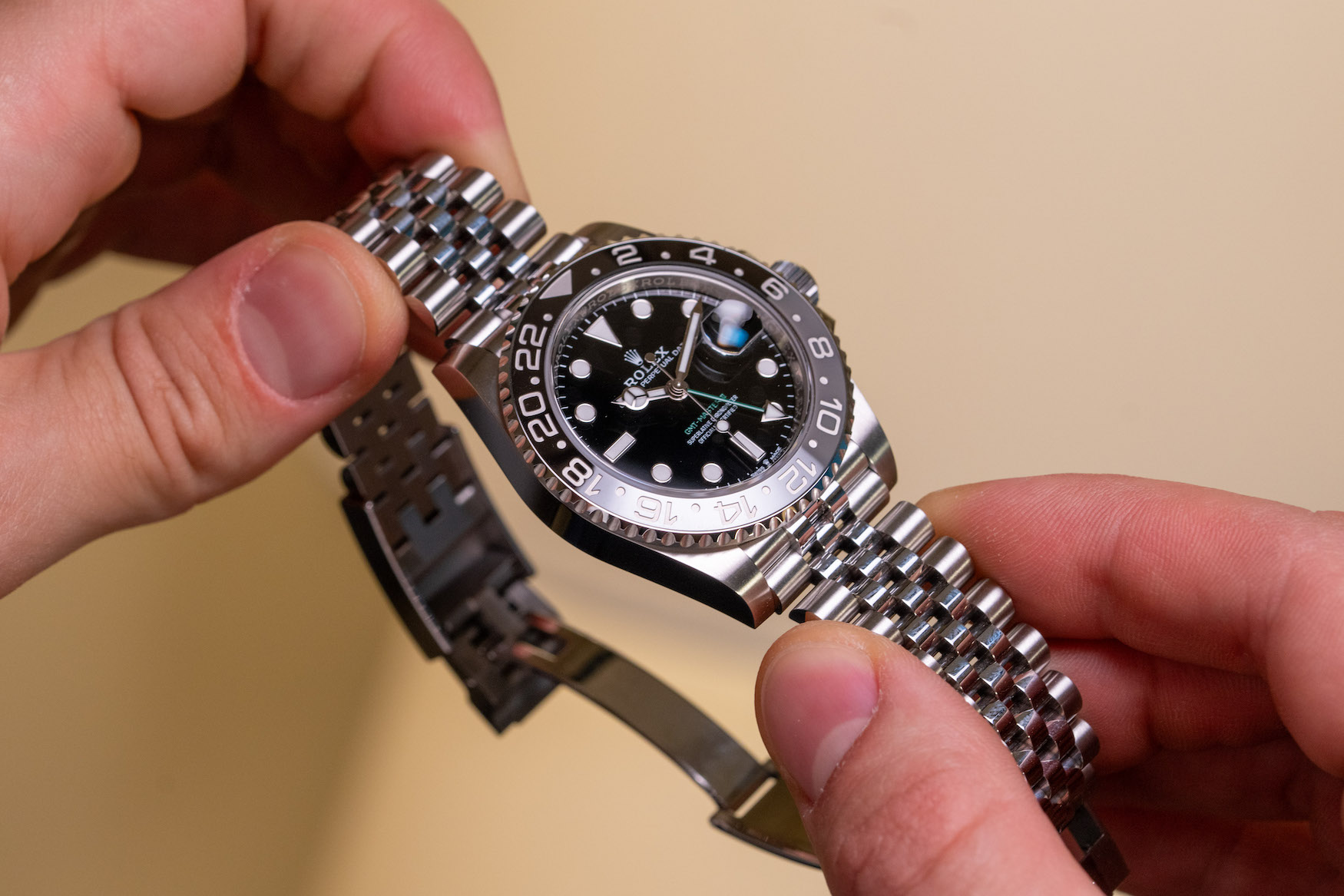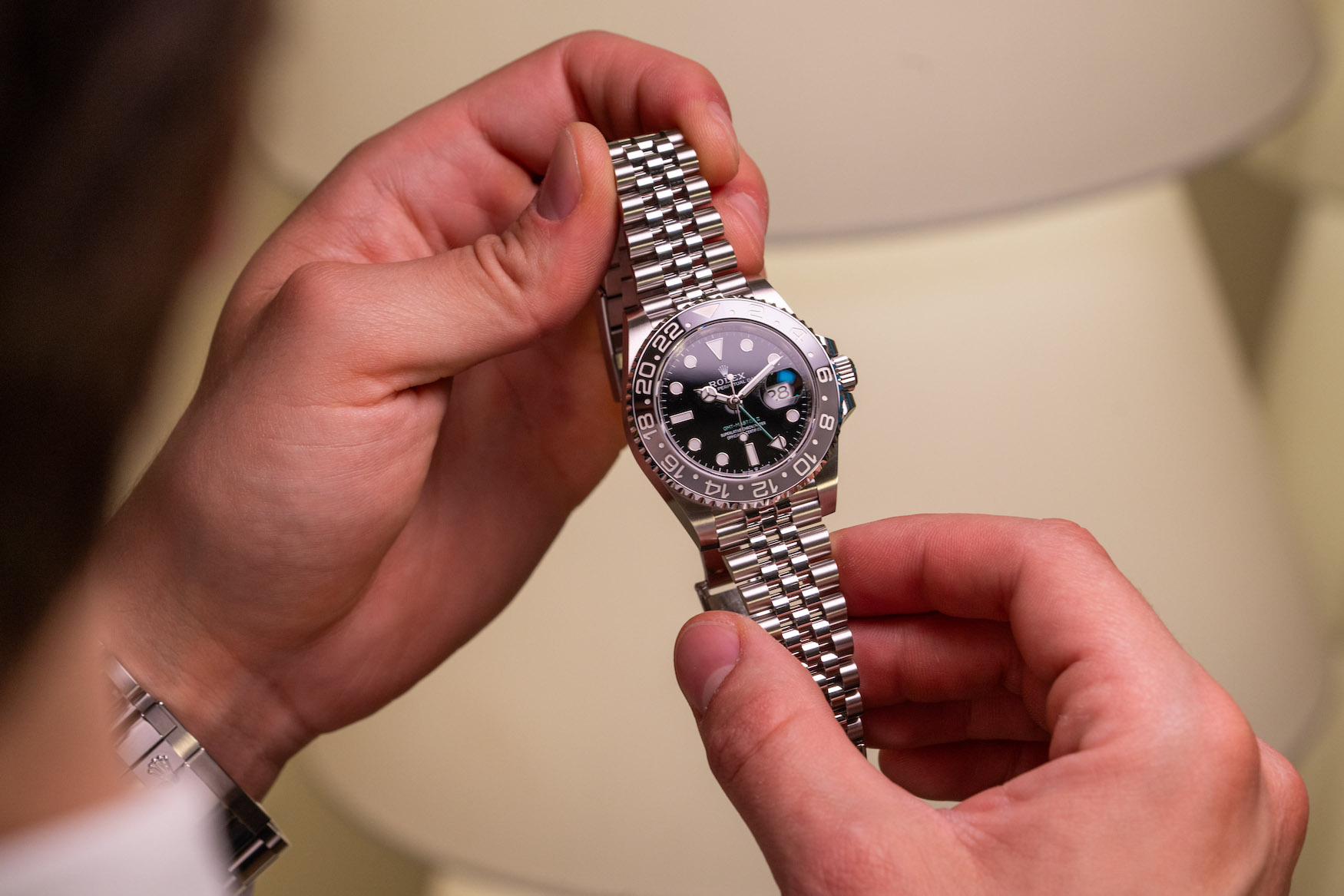Oyster vs Jubilee: Which bracelet does the Rolex GMT-Master II look better on?
Zach BlassDavid versus Goliath, Achilles versus Hector, and now, Zach versus Borna. Wait… Why am I talking in the third person? Alas, today I find myself in a battle for glory. A battle as old as time, or, rather, as old as 1959 when the Rolex GMT-Master II was first introduced on a Jubilee bracelet alongside the Oyster from four years earlier. Often with Rolex, you are limited to one factory option for the bracelet that is paired with your watch. The GMT-Master II, however, as of 2021, is one rare example of a professional Rolex model where you have two options to explore when configuring your purchase. As the latest GMT-Master II ref. 126710GRNR was presented to us in our Rolex Watches and Wonders appointment, the two configurations were passed around – my personal favourite on a Jubilee in my hand, and the Oyster version in Borna’s. As I proclaimed that the GMT-Master II looks its best on the Jubilee, Borna scoffed in dissent favouring it on the Oyster bracelet.
View this post on Instagram
In the reel above you will see the beginnings of our debate, but we decided, in our professionalism, to park the conversation to save it for the ring (the Time+Tide website), and that’s what you’re seeing here. Admittedly, as much as it pains me to say, there is no one right answer – this is, of course, completely subjective. But, it is now time to see which of us in your hearts will be the victor and who will be sent to horological Valhalla.
The Rolex GMT-Master II looks best on a Jubilee bracelet (#teamzach)
I once posed this question to Kevin O’Leary (a.k.a Mr. Wonderful), of Shark Tank fame during a Clubhouse chat with Bob’s Watches back during the pandemic when Clubhouse was actually still a thing. Kevin was definitely team Oyster, citing that vintage jubilee bracelets are a pain to maintain and don’t have the same solidity and robustness as its Oyster counterpart. But the modern Jubilee is stronger than ever, with rattle stretch bracelets a thing of the past across all modern bracelet styles. It is also, in my opinion, much more comfortable on the wrist. When you consider that all the Rolex bracelets today effectively have equal solidity and robustness, I am going to hone in strictly on the aesthetic.

I’ll concede this: there is nothing objectively wrong with a GMT-Master II on an Oyster bracelet. It is, after all, the bracelet it was born on in 1955. But in the modern catalogue you are not getting a fully brushed Oyster, instead you get the centre polished links that you would find on a Rolex Datejust. I think this is a miscalculation on Rolex’s part, ultimately offering two bracelets with a sense of elegance rather than one option that leans more into a tool watch aesthetic and another leaning into a more elevated look. In my opinion the Jubilee will always better convey sophistication than the Oyster, and the Jubilee better evokes the cosmopolitan coolness of the golden age of flying as well. When the watch was introduced in the 1950s, air travel was still a very sophisticated affair, with travellers suiting up like Don Draper as they flew around the world. The Submariner and Explorer are your no glamour tool watches. The GMT-Master II, tied to the class of traversing the sky, is a much more glamorous affair then diving into water or hiking up mountains.
If the Oyster bracelet offered today for the GMT-Master II were fully brushed, I would understand people saying it better evokes GMT-Master watches of the past. But, as it stands, the Jubilee configuration is the only style that truly pays tribute to those early Rolex GMT-Master watches and the golden age imagery that has made it a lasting icon to this day. The current mixed-finished Oyster bracelet has one foot on each side of the spectrum, neither perfectly embodying the tool watch or classy watch – a bit of an identity crisis. Whenever I see a modern Submariner or Daytona somehow on a Jubilee instead of an Oyster, admittedly I cry foul. Those references are at home on Oyster bracelets, and for the Explorers and Submariners in steel it makes complete sense. Once you jump to precious metal, polished centre links enter the fold – again, makes sense. And, the Daytona now is so far removed from its tool origins as a luxury status symbol with the highest secondary premium. So, I will let the mixed finished Oyster stand. For the modern GMT-Master II, however, I will always ride or die for team Jubilee. It distinguishes it better from the Submariner, which, aside from its bezel scale and the number of central hands, is identical in design. Cosmopolitan pilot’s watch. The word cosmopolitan justifies the Jubilee alone.
The Rolex GMT-Master II looks best on a Oyster bracelet (#teamborna)
Right out of the gate, I have to come out with a disclaimer. I firmly believe that the Oyster bracelet looks best on a modern Rolex GMT. There’s a few reasons for this, and the first is the way the watch has evolved throughout the years. Pick up any GMT with a ceramic bezel, and the size and shape of its numerals, as well as the large features of the dial just don’t gel well with the fine(r) links of the Jubilee in my opinion. The inherent bulkiness and brawniness of any modern Rolex (admit it, it’s true), work better with the wider, flat surfaces of the Oyster. In my eyes, this also has nothing to do with the historical implications of the GMT being born on an Oyster bracelet. Just because it was created as such doesn’t mean it’s the be-all and end-all of GMT designs, though I see how that could influence someone’s preferences.
Now, Zach does bring up a good point when it comes to polished and brushed surfaces. I completely agree that the Oyster would work better if it was fully brushed, but I feel like that’s a moot point to make considering the fact that the Jubilee is even blingier with its multi-piece construction. And that leads me to my biggest problem with the modern Rolex Jubilee, and not just when it comes to fitting it on a GMT-Master II. For me, the charm of a Jubilee bracelet is in its slight jankiness and rattliness, giving it supreme comfort on the wrist. The modern ones don’t have any of that thanks to superior manufacturing, but I feel like some of the charm is lost along with it. When it comes to dressier pieces like a fluted-bezel Datejust or the Jubilee’s cousin, the President bracelet on a Day-Date, I have no qualms. Why? Because they’re embodiments of what modern Rolex has become.

If we’re talking Rolex GMT watches and their accompanying bracelets in general, in my opinion, nothing beats a nipple dial Rootbeer on a jangly Jubilee. But if I was ushered into a Rolex boutique today and made to pick out a new one, I have no doubts it would be this very watch – the monochromatic GMT 126710 on an Oyster bracelet… That I would then proceed to sell and buy a vintage one.
Now that we have both said our piece, it is now up to you: the Time+Tide Tribe. Let us know your thoughts and your votes for who here is the winner, siding with #teamzach in favour of the Jubilee bracelet or #teamborna in favour of the Oyster bracelet.









